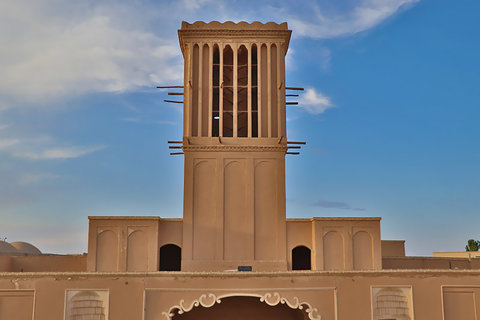Iran (IMNA) - The function of this tower is to catch cooler breeze that prevail at a higher level above the ground and to direct it into the interior of the buildings. It is not known who first invented the windcatcher, although some claim it originated in Iran and it can be seen in.

Windcatchers come in various designs, such as the uni-directional, bi-directional, and multi-directional. Examples of windcatchers can be found in traditional Persian influenced architecture throughout the Middle East , Pakistan and Afghanistan. Central Iran has a very large day-night temperature difference, ranging from cool to extremely hot, and the air tends to be very dry all day long.
Most buildings are constructed of very thick ceramics with extremely high insulation values. Furthermore, towns centered on desert oases tend to be packed very closely together with high walls and ceilings relative to Western architecture, maximizing shade at ground level. The heat of direct sunlight is minimized with small windows that do not face the sun.
The windcatcher functions on several principles:
First, a windcatcher is capped and has several directional ports at the top (traditionally four). By closing all but the one facing away from the incoming wind, air is drawn upwards using the Coanda effect, similar to how opening one facing the wind would push air down the shaft. This generates significant cooling ventilation within the structure below, but is not enough to bring the temperature below ambient alone - it would simply draw hot air in through any cracks or windows in the structure below.

Therefore, the key to generating frigid temperatures seems to be that there are very few cracks at the base of the thick structure below, but there is a significant air gap above the qanat (a water management system used to provide a reliable supply of water to human settlements or for irrigation in hot, arid and semi-arid climates). A qanat has quite a lot of water inside, because there are frequent well-like reservoirs along its path. Completely shaded from the sun, a qanat also aggregates the cold, sinking air of the night, which is then trapped within, unable to rise up to the less dense surface air. A windcatcher, however, can create a pressure gradient which sucks at least a small amount of air upwards through a house. This cool, dry night air, being pulled over a long passage of water, evaporates some of it and is cooled down further.
Finally, in a windless environment or waterless house, a windcatcher functions as a Solar or thermal chimney that uses convection of air heated by passive solar energy. It creates a pressure gradient which allows less dense hot air to travel upwards and escape out the top. This is also compounded significantly by the day-night cycle mentioned above, trapping cool air below. The temperature in such an environment can't drop below the nightly low temperature. These last two functions have gained some ground in Western architecture, and there are several commercial products using the name windcatcher.

When coupled with thick adobe - a natural building material made from earth, shaped into bricks using forms and dried in the sun - that exhibits high heat transmission resistance qualities, the windcatcher is able to chill lower-level spaces in mosques and houses in the middle of the day to cooler temperatures.
So effective has been the windcatcher in Persian architecture that it has also been routinely used as a refrigerating device.
Many traditional water reservoirs, or ab anbars, are built with windcatchers that are capable of storing water at near freezing temperatures for months in summer. High humidity environments destroy the evaporative cooling effect enjoyed in the dry conditions seen on the Iranian plateau; hence the ubiquitous use of these devices in drier areas such as Yazd, Kashan, Nain, and Bam.
A small windcatcher (badgir) is called a "shish-khan" in traditional Persian architecture. Shish-khans can still be seen on top of ab anbars in Qazvin, and other northern cities in Iran. These seem to be more designed as a pure ventilating device, as opposed to temperature regulators, as their larger cousins in the central deserts of Iran are.

Wind Catchers in the Persian Gulf Countries
The emergence of a traditional Bahraini and Persian Gulf style of architecture arose as people migrated to Bahrain with the growth of the pearl trade. With newfound wealth, the merchants built houses of note in the 18th and 19th centuries. The people of Ahvaz in Iran, for example, came and brought with them new architectural designs, including the distinctive wind tower which can be seen so prominently in the Awadiya area and elsewhere in Bahrain. This distinguishing feature was adapted locally with its own distinctive decorative motifs. The wind tower, an early and very effective form of air conditioning, has in fact been around for about 500 years and was developed from the early Wind Scoops first built about 2,000 years ago in Iran.
In Muharraq and also in parts of Manama there are many buildings, which are no more than two stories high and houses built with natural ventilation, using wind towers and badghirs, the devices for speeding up the flow of air and which consists of horizontal slats in the lower part of the walls. Badghir means ‘wind trap’ and is also the word used to describe the wind tower.

Source: solaripedia


Your Comment